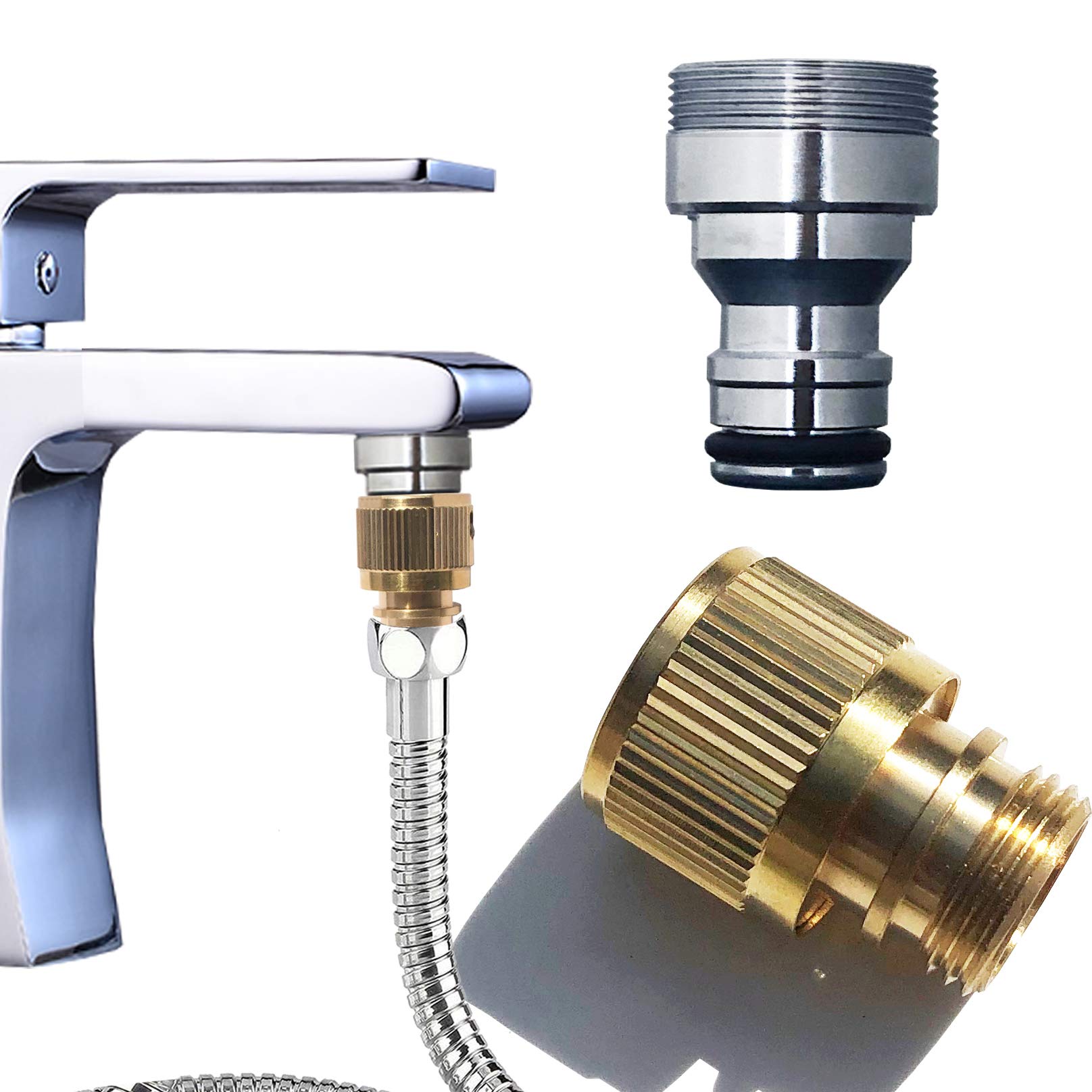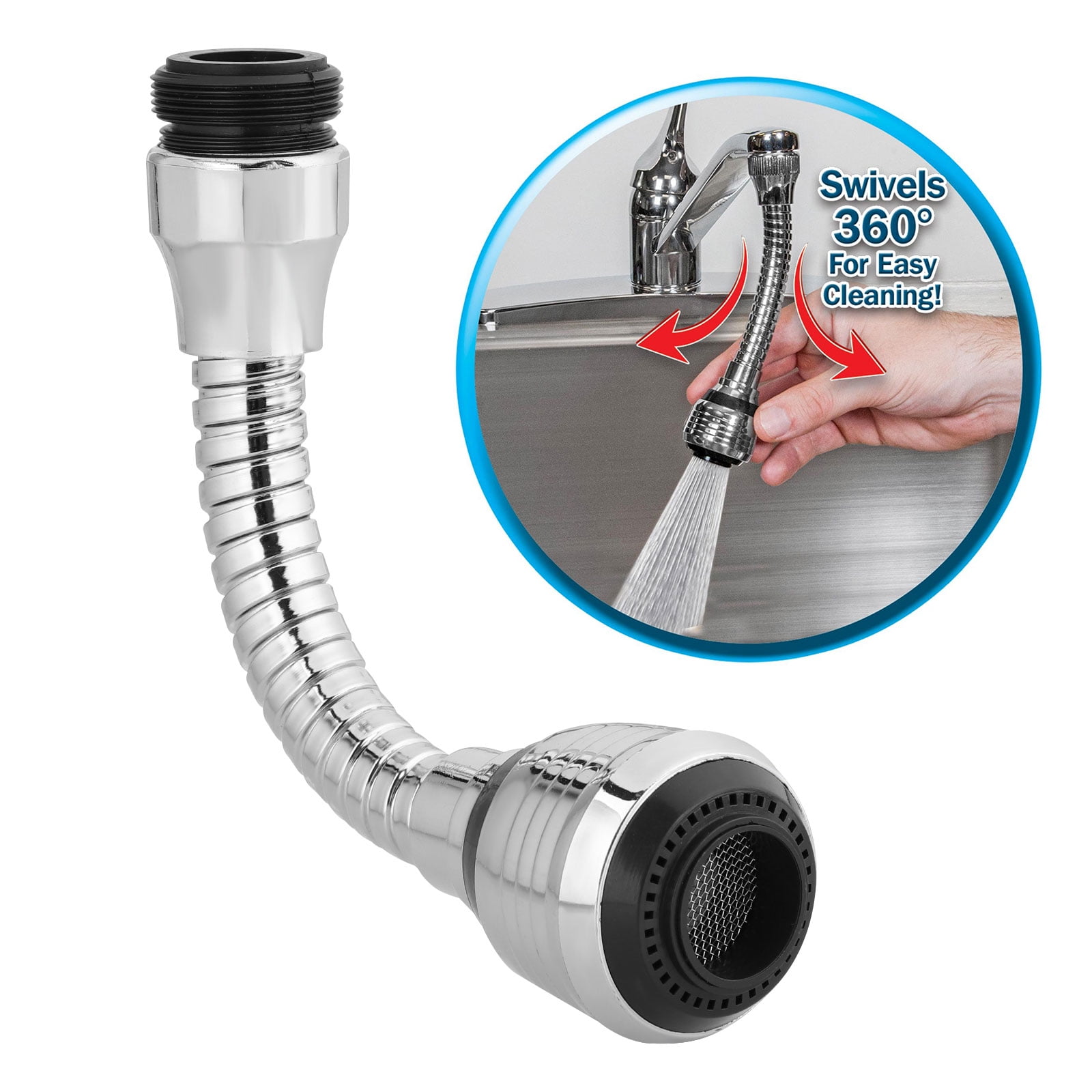What is a Bathroom Faucet Hose Adapter?

A bathroom faucet hose adapter is a small but essential plumbing component that allows you to connect a hose to your bathroom faucet. It acts as a bridge between the standard faucet threads and the hose’s connection, making it possible to use a hose for various purposes, such as filling a bucket, cleaning the bathroom, or even connecting to a handheld showerhead.
Types of Bathroom Faucet Hose Adapters
Bathroom faucet hose adapters come in different types, each designed to accommodate specific faucet styles and hose sizes. Here are some common types:
- Standard Adapter: This type is the most common and features a male threaded end that screws onto the faucet spout and a female threaded end for attaching a hose. It’s typically compatible with most standard bathroom faucets.
- Aerator Adapter: This adapter is specifically designed for faucets with aerators. It has a threaded section that replaces the aerator, allowing you to connect a hose directly to the faucet.
- Swivel Adapter: This adapter provides flexibility, allowing you to easily rotate the hose connection for better maneuverability. It’s particularly useful for tasks that require moving the hose around, like cleaning the bathtub or sink.
- Hose Extension Adapter: This adapter extends the reach of the hose, making it easier to reach areas that are far from the faucet. It’s helpful for filling large containers or cleaning hard-to-reach spots.
- Hose Splitter Adapter: This adapter allows you to connect two hoses to a single faucet, enabling simultaneous use for multiple purposes. It’s handy for tasks like filling two containers or connecting a handheld showerhead while still having access to the faucet spout.
Benefits of Using a Bathroom Faucet Hose Adapter
A bathroom faucet hose adapter offers numerous benefits, making it a valuable addition to any bathroom. These adapters can significantly improve functionality, convenience, and even safety in your bathroom. They offer a simple yet effective solution to common bathroom problems, enhancing the overall user experience.
Increased Reach and Flexibility
Bathroom faucet hose adapters are designed to extend the reach of your existing faucet, providing greater flexibility and convenience. This added reach can be particularly helpful for tasks that require you to move the water source further, such as:
- Washing your hair in the sink without having to bend over.
- Filling large containers or buckets with ease.
- Reaching hard-to-access areas of the sink or bathtub.
The flexible hose allows you to direct the water flow precisely where you need it, making cleaning and rinsing tasks much easier.
Installation and Compatibility
Installing a bathroom faucet hose adapter is a straightforward process that typically involves a few simple steps. It’s essential to understand the compatibility of your faucet with the adapter to ensure a seamless and successful installation.
Installation Process
Installing a bathroom faucet hose adapter is generally a straightforward process that can be done by most homeowners with basic DIY skills. Here’s a typical installation process:
- Turn off the water supply: Locate the shut-off valve for your bathroom sink and turn it off to prevent water from flowing during installation.
- Disconnect the existing hose: Unscrew the old hose from the faucet spout. If the hose is old or worn, it’s a good time to replace it.
- Attach the adapter: Screw the hose adapter onto the faucet spout. Some adapters may require a wrench for a secure fit.
- Connect the new hose: Attach the new hose to the adapter, ensuring a tight connection.
- Turn the water back on: Slowly turn the water supply back on and check for any leaks.
Compatibility with Bathroom Faucets
It’s crucial to ensure that your bathroom faucet is compatible with a hose adapter before purchasing one. Here are the common types of bathroom faucets that typically work with hose adapters:
- Standard single-handle faucets: These are the most common types of faucets found in bathrooms. They typically have a single handle for controlling both hot and cold water flow.
- Two-handle faucets: These faucets have separate handles for controlling hot and cold water flow.
- Centerset faucets: These faucets have a single handle located in the center of the faucet body. They are often found in older bathrooms.
It’s important to note that some specialty faucets, such as those with integrated sprayers or unique designs, may not be compatible with standard hose adapters.
Checking Compatibility
Before purchasing a bathroom faucet hose adapter, it’s crucial to check its compatibility with your faucet. Here are some key factors to consider:
- Faucet spout size: The adapter’s size must match the size of your faucet spout.
- Thread type: The adapter’s thread type must be compatible with the threads on your faucet spout.
- Faucet design: Some faucets have unique designs that may not be compatible with standard hose adapters.
Checking the product description or contacting the manufacturer for compatibility information is recommended.
Considerations for Choosing a Bathroom Faucet Hose Adapter

Choosing the right bathroom faucet hose adapter is crucial to ensure compatibility, functionality, and longevity. Several factors come into play when making this decision, impacting the overall performance and ease of use.
Compatibility with Existing Faucet
Compatibility with your existing faucet is paramount. Different faucets have varying thread sizes and configurations, requiring specific adapter types.
- Thread Size: Check the thread size of your faucet. Common sizes include 1/2″ and 3/4″.
- Faucet Type: Determine the type of faucet you have, such as a single-handle, double-handle, or pull-down. Some adapters are specifically designed for certain faucet types.
- Material: Consider the material of your faucet and choose an adapter made of compatible material, such as brass or stainless steel.
Material and Construction
The material and construction of the adapter play a significant role in its durability and resistance to corrosion.
- Brass: Brass adapters are known for their durability, corrosion resistance, and aesthetic appeal.
- Stainless Steel: Stainless steel adapters are also durable and resistant to corrosion, making them suitable for environments with high moisture levels.
- Plastic: Plastic adapters are often less expensive but may not be as durable or resistant to corrosion as metal alternatives.
Hose Length and Flexibility
The length and flexibility of the hose are crucial for comfortable and convenient use.
- Hose Length: Choose a hose length that allows for easy reach and maneuverability, considering the distance between the faucet and the sink or shower head.
- Flexibility: A flexible hose provides greater ease of movement and reduces strain on the adapter and faucet.
Flow Rate and Pressure
The adapter should not restrict the flow rate or pressure of your faucet.
- Flow Rate: Look for adapters with a flow rate that matches or exceeds the flow rate of your faucet to ensure optimal water flow.
- Pressure: Ensure the adapter can withstand the pressure of your water system to prevent leaks or damage.
Additional Features
Some adapters come with additional features that enhance functionality and ease of use.
- Swivel: A swivel feature allows for greater flexibility and maneuverability of the hose.
- Shut-off Valve: A shut-off valve provides convenient control over water flow.
- Leak-proof Design: Look for adapters with leak-proof designs to prevent water leaks and drips.
Maintenance and Care
A bathroom faucet hose adapter, like any other plumbing fixture, requires proper maintenance to ensure its longevity and optimal performance. Regular cleaning and inspection are crucial for preventing leaks, ensuring smooth operation, and extending its lifespan.
Cleaning and Inspection
Maintaining a bathroom faucet hose adapter is relatively straightforward. It involves a few simple steps to keep it clean and functioning correctly.
- Regular Cleaning: Wipe down the adapter’s surface with a damp cloth to remove dirt, grime, and mineral deposits. You can use a mild soap solution if needed. Avoid using abrasive cleaners that could damage the finish.
- Inspect for Leaks: Check the adapter and its connections for any signs of leaks, such as dripping or water seeping out. Tighten any loose connections or replace worn-out washers or O-rings as necessary.
- Check for Corrosion: Examine the adapter for signs of corrosion, especially around the metal parts. Corrosion can weaken the adapter and lead to leaks. If you notice corrosion, consider replacing the adapter.
Troubleshooting Common Problems
Common problems with bathroom faucet hose adapters can often be resolved with simple troubleshooting steps.
- Leaking: If the adapter is leaking, check the connections for tightness and inspect the washers or O-rings for wear. Replace any damaged parts.
- Restricted Water Flow: If the water flow is restricted, check the adapter’s screen for clogs. Clean the screen with a small brush or toothpick.
- Loose Connection: If the adapter is loose, tighten the connection. Ensure that the adapter is securely fastened to the faucet and the hose.
Identifying Signs of Wear and Tear
Recognizing signs of wear and tear can help you address potential problems before they escalate.
- Cracks or Chips: Look for any cracks or chips in the adapter’s plastic or metal components. These can indicate weakness and potential leaks.
- Corrosion: As mentioned earlier, corrosion can weaken the adapter and lead to leaks. Inspect for any signs of rust or discoloration.
- Loose Fittings: Check for any loose fittings or connections. These can cause leaks or restrict water flow.
Alternative Solutions
While a bathroom faucet hose adapter offers convenience and flexibility, it’s not the only solution for connecting hoses to your bathroom faucet. Here are some alternative approaches, each with its own set of pros and cons:
Using a Separate Faucet
Installing a dedicated faucet with a built-in hose connection is a viable alternative to using an adapter. This approach eliminates the need for an adapter and offers a more integrated solution.
Advantages:
- Integrated Design: A dedicated faucet with a hose connection provides a seamless and integrated solution, eliminating the need for adapters or separate attachments.
- Enhanced Durability: A dedicated faucet with a hose connection is typically designed for frequent use and is more durable than a simple adapter.
- Aesthetic Appeal: Dedicated faucets come in various styles and finishes, allowing you to choose one that complements your bathroom decor.
Disadvantages:
- Higher Cost: Installing a new faucet is more expensive than using an adapter.
- Installation Complexity: Installing a new faucet requires plumbing skills and may involve additional work.
- Limited Adaptability: A dedicated faucet may not be as versatile as an adapter, as it’s designed for a specific purpose.
Utilizing a Sprayer Attachment
Many bathroom faucets come equipped with a built-in sprayer attachment, which can be used for various tasks, including cleaning and rinsing. While not as flexible as a hose adapter, it offers a convenient alternative.
Advantages:
- Built-in Functionality: Sprayer attachments are often included with bathroom faucets, eliminating the need for separate purchases.
- Easy to Use: Sprayer attachments are typically easy to operate and provide a targeted stream of water.
- Cost-Effective: Sprayer attachments are generally less expensive than hose adapters.
Disadvantages:
Employing a Handheld Shower Head, Bathroom faucet hose adapter
Handheld shower heads offer flexibility and control over water flow, making them a versatile alternative to hose adapters.
Advantages:
- Versatility: Handheld shower heads can be used for showering, rinsing, and other tasks that require a flexible water source.
- Control over Water Flow: Handheld shower heads allow you to adjust the water flow and spray pattern.
- Increased Accessibility: Handheld shower heads can be used for showering from a seated position or for reaching difficult-to-access areas.
Disadvantages:
- Potential for Water Splashes: Handheld shower heads can lead to water splashes if not used carefully.
- Installation Complexity: Installing a handheld shower head may require some plumbing knowledge.
- Limited Reach: While more flexible than sprayer attachments, handheld shower heads still have a limited reach compared to hose adapters.
